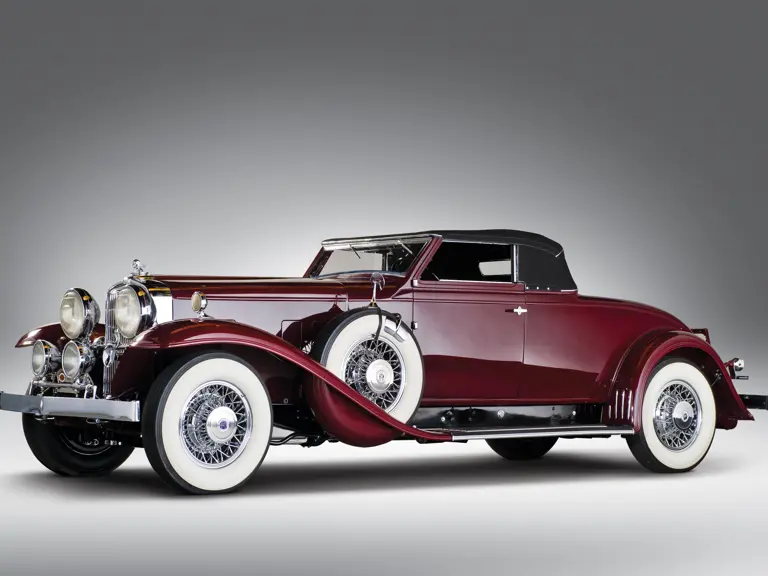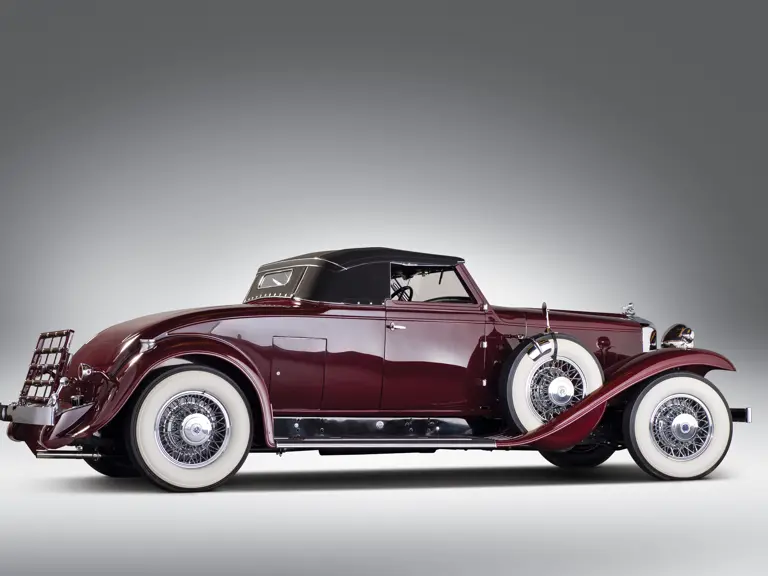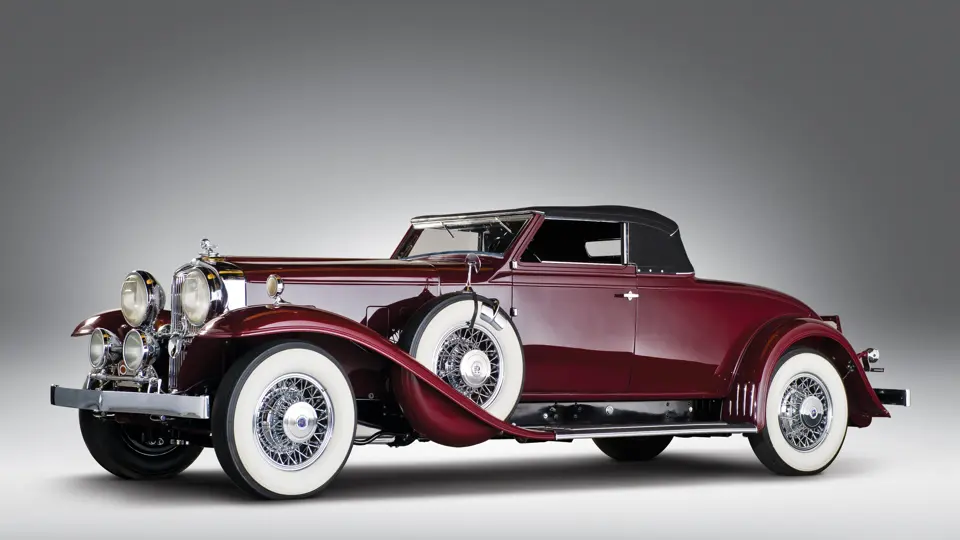156 bhp, 322.1 cu. in. dual overhead camshaft inline eight-cylinder engine, four-speed manual transmission, solid front axle and live rear axle with semi-elliptic leaf springs, and four-wheel vacuum-assisted hydraulic drum brakes. Wheelbase: 145"
• Rare convertible coupe based on an original Rollston design
• Legendary four-valve DV-32 power
• Lovely restoration and design
For 1931, Stutz returned to its roots with a new dual valve engine. Announced in May 1931, the DV-32 (DV for “Dual Valve,” 32 for their number, what we now call a “four-valve engine”) was the company’s vertical eight updated with twin overhead cams for better breathing. Its breathing was so deep that power jumped by 40 percent, to 156 bhp. At nearly half-a-horsepower per cubic inch, it surpassed all but the Duesenberg in volumetric efficiency.
By the time the DV-32 was introduced, however, Stutz’s day was nearly over. Just 384 cars of all types were built by Stutz in 1931, with about 120 the following year. Nearly that many saw life in 1933, but that was about the end. Just six cars, indistinguishable from ’33s, were built in 1934. Stutz’s day had reached its sunset, making these examples from the final years of production very rare indeed in today’s market.
While not badged as such, Stutz’s standard bodies were built by LeBaron and delivered to Indianapolis “in the white,” primed but devoid of trim. In addition, the company catalogued an array of coachbuilt bodies from the likes of LeBaron, Rollston and Brunn, particularly on long-wheelbase models.
The Rollston Company was founded in New York City in 1921. A small firm, it became known for high quality construction techniques and trim. Packard soon became Rollston’s best customer. The company’s busiest period comprised 1927 to 1931, during which time more than 50 bodies per year were delivered on chassis ranging from Bugatti, Buick, Cadillac and Chrysler to Packard, Peerless, Pierce-Arrow, Stearns Knight and Stutz.
The 1932 Stutz catalogue listed no fewer than three Rollston styles on the 145-inch DV-32 chassis, a convertible victoria, Hollywood sport sedan and Tuxedo cabriolet. Others were entirely bespoke and built only to order.
The Stutz offered here has an intriguing history. According to extensive research by RM Auctions in conjunction with recognized Stutz authorities, this car was built new with Stutz body style MB47, a lovely convertible coupe on the long wheelbase chassis. The car is presented today with a sporting, lowered and raked windshield, a modification that was made to the car much earlier in its history, likely in the 1950s. The car was fully restored in Michigan beginning in the 1980s while in Mr. Richard Sahlin’s ownership. At this time, the car was upgraded to DV-32 specification from its original SV-16 specification. Additionally, the coachwork was modified to faithfully duplicate a handsome Rollston convertible coupe design, which existed in company literature but never came to fruition on a Stutz chassis despite being utilized on both Cadillac V-16 and Duesenberg chassis.
Today the car still presents very nicely in maroon with chrome wire wheels. The body contours are excellent, and the doors exhibit nice, even gaps. The paint exhibits a deep shine, and all brightwork, headlined by the massive Ryan-Lite headlamps, is very good. The car is also equipped with Pilot Ray driving lights.
The interior is upholstered in black leather, which shows some very minor cracking on the seat cushion, but otherwise remains in excellent condition. There is black carpet on the floor, and the instrument panel is an attractive contrast of maroon and wood grain with an unblemished steering wheel. A two-layer liner complements the black canvas top, which is excellent throughout, with no shrinkage, stretching or staining.
The engine compartment is highly detailed and most attractive, in green paint and polished aluminum. The chassis, painted black, is very clean, as is the maroon underbody. A rear-mounted trunk rack, in body color with varnished wood ribs, stands ready to carry a tour’s worth of luggage for two. The car received Antique Automobile Club of America National First honors in 1990 and a Senior Premier First in Classic Car Club of America national competition.
Stutz production in 1932 barely reached 100. This car, then, is one of a very select few. It is beautifully presented in a lovely color with a sporting stance and truly lovely coachwork based on the work of a highly respected firm.




 | Boca Raton, Florida
| Boca Raton, Florida


